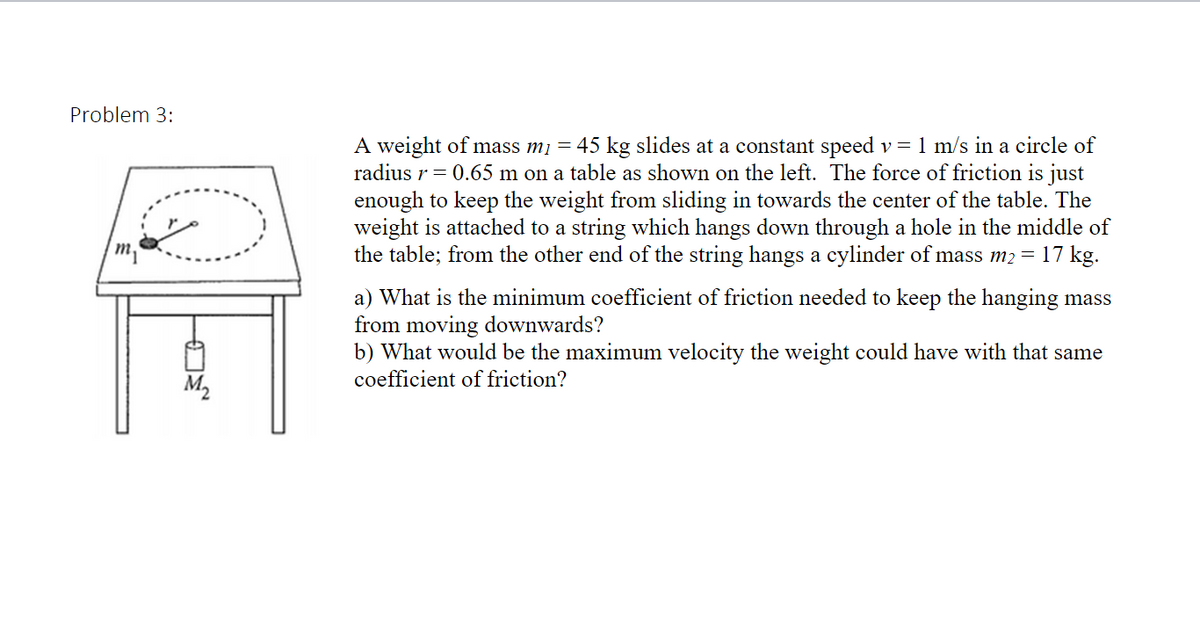A weight of mass mį = 45 kg slides at a constant speed v = 1 m/s in a circle of radius r = 0.65 m on a table as shown on the left. The force of friction is just enough to keep the weight from sliding in towards the center of the table. The weight is attached to a string which hangs down through a hole in the middle of the table; from the other end of the string hangs a cylinder of mass m2 =17 kg. a) What is the minimum coefficient of friction needed to keep the hanging mass from moving downwards? b) What would be the maximum velocity the weight could have with that same coefficient of friction?
A weight of mass mį = 45 kg slides at a constant speed v = 1 m/s in a circle of radius r = 0.65 m on a table as shown on the left. The force of friction is just enough to keep the weight from sliding in towards the center of the table. The weight is attached to a string which hangs down through a hole in the middle of the table; from the other end of the string hangs a cylinder of mass m2 =17 kg. a) What is the minimum coefficient of friction needed to keep the hanging mass from moving downwards? b) What would be the maximum velocity the weight could have with that same coefficient of friction?
College Physics
11th Edition
ISBN:9781305952300
Author:Raymond A. Serway, Chris Vuille
Publisher:Raymond A. Serway, Chris Vuille
Chapter7: Rotational Motion And Gravitation
Section: Chapter Questions
Problem 27P: An air puck of mass m1 = 0.25 kg is tied to a siring and allowed to revolve in a circle of radius R...
Related questions
Question
100%

Transcribed Image Text:Problem 3:
A weight of mass m1 =
45 kg slides at a constant speed v = 1 m/s in a circle of
radius r = 0.65 m on a table as shown on the left. The force of friction is just
enough to keep the weight from sliding in towards the center of the table. The
weight is attached to a string which hangs down through a hole in the middle of
the table; from the other end of the string hangs a cylinder of mass m2 =
m
17 kg.
a) What is the minimum coefficient of friction needed to keep the hanging mass
from moving downwards?
b) What would be the maximum velocity the weight could have with that same
coefficient of friction?
M2
Expert Solution
This question has been solved!
Explore an expertly crafted, step-by-step solution for a thorough understanding of key concepts.
This is a popular solution!
Trending now
This is a popular solution!
Step by step
Solved in 4 steps with 3 images

Knowledge Booster
Learn more about
Need a deep-dive on the concept behind this application? Look no further. Learn more about this topic, physics and related others by exploring similar questions and additional content below.Recommended textbooks for you

College Physics
Physics
ISBN:
9781305952300
Author:
Raymond A. Serway, Chris Vuille
Publisher:
Cengage Learning

Principles of Physics: A Calculus-Based Text
Physics
ISBN:
9781133104261
Author:
Raymond A. Serway, John W. Jewett
Publisher:
Cengage Learning

College Physics
Physics
ISBN:
9781305952300
Author:
Raymond A. Serway, Chris Vuille
Publisher:
Cengage Learning

Principles of Physics: A Calculus-Based Text
Physics
ISBN:
9781133104261
Author:
Raymond A. Serway, John W. Jewett
Publisher:
Cengage Learning